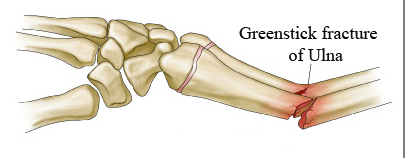Greenstick Fractures Causes, Symptoms, Diagnosis and Treatment

What are Greenstick Fractures?
A greenstick fracture is a fracture in a young, soft bone in which the bone bends and breaks.
A greenstick fracture occurs when a bone bends and cracks, instead of breaking completely into separate pieces. Therefore it is called incomplete broken bone.
This type of broken bone most commonly occurs in children because their bones are softer and more flexible than are the bones of adults.
In some cases, a greenstick fracture can be difficult to diagnose because there may not be much pain or swelling and the child is using the limb and has full motion.
Mild greenstick fractures sometimes are thought to be sprains, although they too may require casts.
Causes of Greenstick Fractures:
Greenstick fractures occur when the force applied to a bone results in bending of the bone such that the structural integrity of the convex surface is overcome.
The fact that the integrity of the cortex has been overcome results in fracture of the convex surface. However, the bending force applied does not break the bone completely and the concave surface of the bent bone remains intact.
This can occur following an angulated longitudinal force applied down the bone (e.g. an indirect trauma following a fall on an outstretched arm), or after a force applied perpendicular to the bone (e.g. a direct blow).
This fracture is very different, and much less common, than the torus fracture that results in buckling of the cortex on the concave side of the bend and an intact concave surface.
Childhood fractures most commonly occur with a fall. The impact of the fall results in either greenstick fractures, or depending on the force, a complete fracture in that region.
Arm fractures are more common than leg fractures, since the usual reaction is to throw out one’s arms when one starts to fall.
Symptoms of Greenstick Fractures:
The intense pain, swelling and obvious deformity typical of broken bones may be absent or minimal in mild greenstick fractures.
Other greenstick fractures may be easily diagnosed because the arm or leg is deformed and there is significant swelling.
Diagnosis of Greenstick Fracture:
Greenstick fracture is diagnosed via:
- Physical examination
- Doctor will inspect the affected area for tenderness, swelling, deformity or an open wound.
- The child will be asked to gently move that limb’s fingers or toes.
- X-rays
Treatment of Greenstick Fracture:
Greenstick fractures are usually treated via putting a cast to keep the bones in good alignment while the break heals.
If the bones are in a poor alignment, they may need to be repositioned, typically under sedation.
The doctor may insert a removable splint.
Once the cast is removed, one should avoid high impact activities for a few weeks.
By : Natural Health News




